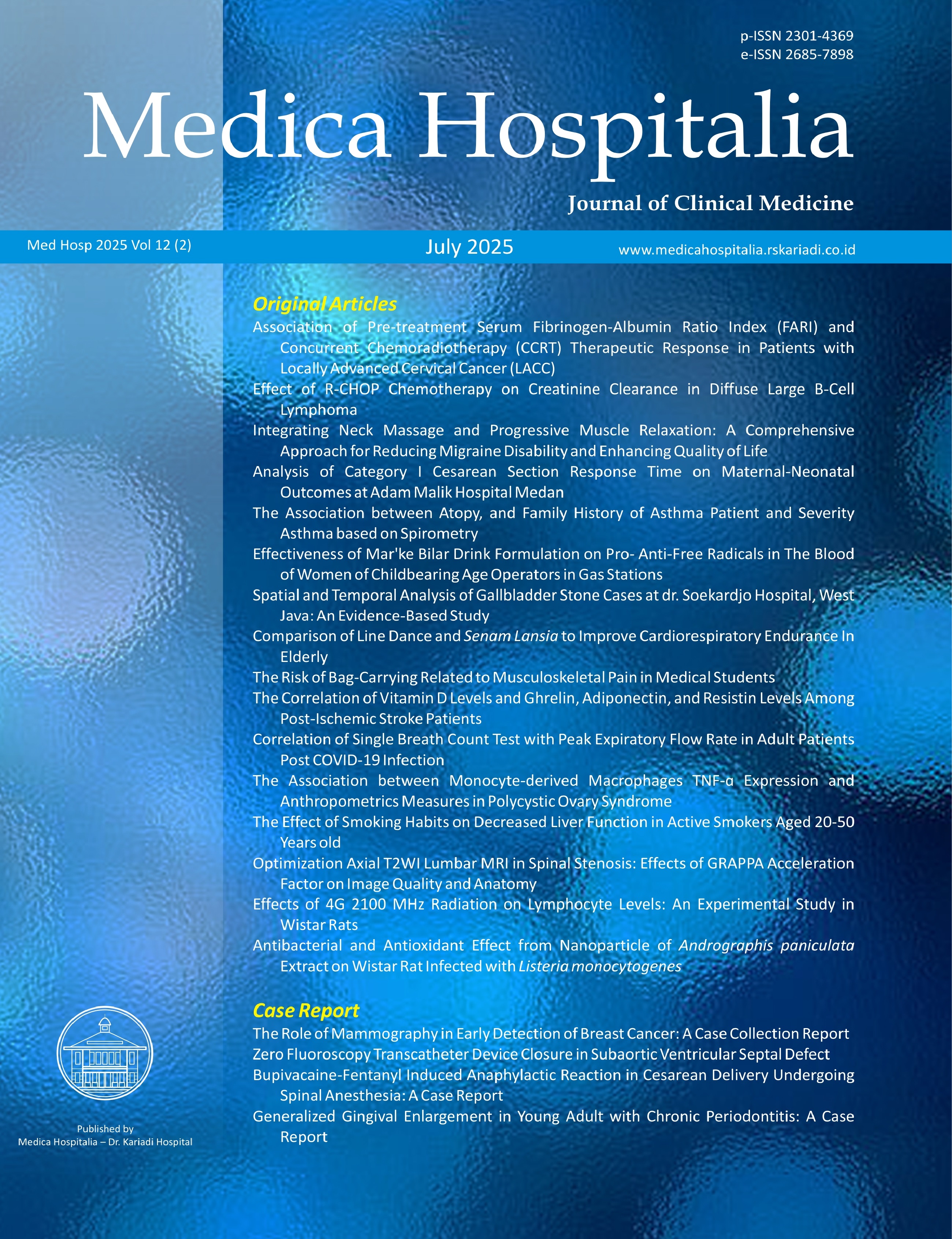Antibacterial and Antioxidant Effect from Nanoparticle of Andrographis paniculata Extract on Wistar Rat Infected with Listeria monocytogenes
DOI:
https://doi.org/10.36408/mhjcm.v12i2.1301Keywords:
Antibacterial , Andrographis paniculata, Antioxidant, Listeria monocytogenes , NanoparticleAbstract
BACKGROUND: Listeria infection triggers the production of ROS (Reactive Oxygen Species) and radical-waste accumulation such as Malondialdehyde (MDA). Andrographis paniculata, triggers the production of Superoxide Dismutase (SOD) as antioxidant and suppresses the bacteria multiplication in host’s body. However, these active-phytochemical have poor destruction due to their large size and molecular weight. Nanoparticle technology may overcome this problem to increase bioavailability and benefit of herbal pharmacology.
AIMS: to evaluate the effectivity nanoparticle of A. paniculata extract to increase bacteria elimination, increase SOD level, and reduce MDA level in rat infected with L. monocytogenes
METHOD: Experimental research with post-test only controlled trial design was conducted using white rats (Rattus novergicus strain Wistar) into Normal (N), Negative Control (K-), A. paniculata extract (EAP-200), and Nanoparticle of A. paniculata extract Group (nEAP-100, nEAP-200, and nEAP-400). Colony was measured using total plate count method. SOD & MDA level were measured using colorimetric method
RESULT: L. monocytogenes bacterial count from group with extract A. paniculata was significantly lower than those in negative control (p<0,05). SOD level from group with extract A. paniculata was very significantly higher than those in negative control (p<0,01), while MDA level from group with extract A. paniculata was very significantly lower than those in negative control (p<0,01). Dose of 200 mg/kgBW in nanoparticle form was the most optimum dose.
CONCLUSION: Extract of A. paniculata at various doses and form, increase bacterial clearance, increase SOD level, and reduce MDA level in rat infected with L. monocytogenes.
Downloads
References
1. Mpundu P, Mbewe AR, Muma JB, Mwasinga W, Mukumbuta N, Munyeme M. A Global Perspective of Antibiotic-Resistant Listeria monocytogenes Prevalence in Assorted Ready to Eat Foods: a Systematic Review. Veterinary World. 2021;14(8):2219-2229. doi:10.14202/vetworld.2021.2219-2229
2. Park M, Horn L, Lappi V, Boxrud D, Hedberg C, Jeon B. Antimicrobial Synergy between Aminoglycosides and Licorice Extract in Listeria monocytogenes. Pathogens. 2022;11(4):1-9. doi:10.3390/pathogens11040440
3. Sibanda T, Buys EM. Listeria monocytogenes Pathogenesis: The Role of Stress Adaptation. Microorganisms. 2022;10(8):1-26. doi:10.3390/microorganisms10081522
4. de Alcântara AI, Mancebo DB, Souza TL, Nunes SL, Vitor LFJ. Anti-inflammatory Activity of Caffeine (1,3,7-trimethylxanthine) after Experimental Challenge with Virulent Listeria monocytogenes in Swiss mice. International Immunopharmacology. 2021;100:1-7. doi:10.1016/j.intimp.2021.108090
5. Xia X, Chen Y, Xu J, Yu C, Chen W. SRC-3 Deficiency Protects Host from Listeria monocytogenes Infection through Increasing ROS Production and Decreasing Lymphocyte Apoptosis. International Immunopharmacology. 2021;96:1-10. doi:10.1016/j.intimp.2021.107625
6. Osek J, Wieczorek K. Listeria monocytogenes—How This Pathogen Uses Its Virulence Mechanisms to Infect the Hosts. Pathogens. 2022;11(12):1-25. doi:10.3390/pathogens11121491
7. Hochnadel I, Hoenicke L, Petriv N, et al. Safety and Efficacy of Prophylactic and Therapeutic Vaccine Based on live-attenuated Listeria monocytogenes in Hepatobiliary Cancers. Oncogene. 2022;41(14):2039-2053. doi:10.1038/s41388-022-02222-z
8. Al-Bayati HHK, Alwan MJ. Study on Some Side Effect of Accompaniment of The Listeriosis During Pregnancy. Biochem Cell Arch. 2020;20(2):4693-4700. https://connectjournals.com/03896.2020.20.4693
9. Febrina L, Helmi, Rijai L. Profil Kadar Malondialdehida, Glukosa dan Kolesterol pada Tikus Putih yang Terpapar Asap Rokok. J Trop Pharm Chem . 2016;3(4):277-282. doi:https://doi.org/10.25026/jtpc.v3i4.115
10. Zhang J, Zheng P, Li J, et al. Curcumin-Mediated Sono-Photodynamic Treatment Inactivates Listeria monocytogenes via ROS-Induced Physical Disruption and Oxidative Damage. Foods. 2022;11(6):1-11. doi:10.3390/foods11060808
11. Cesinger MR, Schwardt NH, Halsey CR, Thomason MK, Reniere ML. Investigating the Roles of Listeria monocytogenes Peroxidases in Growth and Virulence. American Society for Microbiology. 2021;9(1):1-14. doi:10.1128/Spectrum
12. Ogundola AF, Akhigbe RE, Saka WA, et al. Contraceptive Potential of Andrographis paniculata is via Androgen Suppression and not Induction of Oxidative Stress in Male Wistar Rats. Tissue and Cell. 2021;73:1-10. doi:10.1016/j.tice.2021.101632
13. Zhang Y, Zhang J, Duan L. The Role of Microbiota-Mitochondria Crosstalk in Pathogenesis and Therapy of Intestinal Diseases. Pharmacological Research. 2022;186:1-7. doi:10.1016/j.phrs.2022.106530
14. Badawy B, Gwida M, Sadat A, et al. Prevalence and Antimicrobial Resistance of Virulent Listeria monocytogenes and Cronobacter sakazakii in Dairy Cattle, the Environment, and Dried Milk with the In Vitro Application of Natural Alternative Control. Antibiotics. 2022;11(8):1-18. doi:10.3390/antibiotics11081087
15. Mehta S, Sharma AK, Singh RK. Pharmacological Activities and Molecular Mechanisms of Pure and Crude Extract of Andrographis paniculata: An update. Phytomedicine Plus. 2021;1(4):1-19. doi:10.1016/j.phyplu.2021.100085
16. Li N, Xu D, Huang RH, et al. A New Source of Diterpene Lactones From Andrographis paniculata (Burm. f.) Nees—Two Endophytic Fungi of Colletotrichum sp. With Antibacterial and Antioxidant Activities. Frontiers in Microbiology. 2022;13:1-16. doi:10.3389/fmicb.2022.819770
17. Bhaisare S, Pathak S, Ajankar V V. Physiological Activities of the King of Bitters (Andrographis paniculata): A Review. Cureus. 2023;15(8):1-6. doi:10.7759/cureus.43515
18. Rajeshkumar S, Santhoshkumar J, Jule LT, Ramaswamy K. Phytosynthesis of Titanium Dioxide Nanoparticles Using King of Bitter Andrographis paniculata and Its Embryonic Toxicology Evaluation and Biomedical Potential. Bioinorganic Chemistry and Applications. 2021;2021:1-11. doi:10.1155/2021/6267634
19. Dappula SS, Kandrakonda YR, Shaik JB, et al. Biosynthesis of Zinc Oxide Nanoparticles using Aqueous Extract of Andrographis alata: Characterization, Optimization and Assessment of Their Antibacterial, Antioxidant, Antidiabetic and Anti-Alzheimer’s properties. Journal of Molecular Structure. 2023;1273:1-15. doi:10.1016/j.molstruc.2022.134264
20. Anantharaman S, Rego R, Muthakka M, Anties T, Krishna H. Andrographis paniculata-mediated Synthesis of Silver Nanoparticles: Antimicrobial Properties and Computational Studies. SN Applied Sciences. 2020;2(9):1-14. doi:10.1007/s42452-020-03394-7
21. Amin R, Apriliandy SM, Purwanita P, Irsan SM. Efficacy of Sambiloto Extracts, Andrographis paniculate, (Burm. F) in Inhibiting Diabetic Retinopathy Progression: An in Vivo Study. Reports of Biochemistry & Molecular Biology. 2022;11(3):1-8. www.RBMB.net
22. Sandhiya V, Ubaidulla U. A Review on Herbal Drug Loaded into Pharmaceutical Carrier Techniques and its Evaluation Process. Future Journal of Pharmaceutical Sciences. 2020;6(1):1-16. doi:10.1186/s43094-020-00050-0
23. Muthulakshmi V, Balaji M, Sundrarajan M. Biomedical Applications of Ionic Liquid Mediated Samarium Oxide Nanoparticles by Andrographis Paniculata Leaves Extract. Materials Chemistry and Physics. 2020;242:1-8. doi:10.1016/j.matchemphys.2019.122483
24. Huong QTT, Nam NTH, Duy BT, et al. Structurally Natural Chitosan Films Decorated with Andrographis Paniculata Extract and Selenium Nanoparticles: Properties and Strawberry Preservation. Food Bioscience. 2023;53:1-11. doi:10.1016/j.fbio.2023.102647
25. Alkhuriji AF, Majrashi NA, Alomar S, et al. The Beneficial Effect of Eco-Friendly Green Nanoparticles Using Garcinia mangostana Peel Extract Against Pathogenicity of Listeria monocytogenes in Female BALB/c Mice. Animals. 2020;10(573):1-14. doi:10.3390/ani10040573
26. Meiyasa F, Sri B, Jenie L, Nuraida L, Tarigan N. The Ability of Lactobacillus plantarum BSL in Reducing The Tissue Damage of Liver and Spleen in Rats Infected by Listeria monocytogenes ATCC 7644. Agrisaintifika (Jurnal Pertanian). 2019;3(2):88-94. doi:https://doi.org/10.32585/ags.v3i2.542
27. Wardani G, Mahmiah, Sudjarwo SA. Immunostimulatory Activity of Chitosan Nanoparticles on Wistar Albino Rats. Pharmacognosy Journal. 2018;10(5):892-898. doi:10.5530/pj.2018.5.150
28. Nitihapsari YG, Sari OP, Ferine M. Pengaruh Ekstrak Jintan Hitam (Nigella sativa) Terhadap TNF-a Mencit Balb-C yang Diinfeksi MRSA. In: Pengembangan Sumber Daya Perdesaan Dan Kearifan Lokal Berkelanjutan IX. Prosiding Seminar Nasional dan Call for Papers; 2019:139-146.
29. Rompas WF, Wewengkang DS, Mpila DA. Antibacterial Activity Test of Lamellodysidea herbacea Sponge Extract from The Waters of Poopoh Village, Minahasa Regency (Uji Aktivitas Antibakteri Ekstrak Spons Lamellodysidea herbacea dari Perairan Desa Poopoh Kabupaten Minahasa). PHARMACON. 2023;12(3):295-301.
30. Mutiarahmi CN, Hartady T, Lesmana R. Use of Mice as Experimental Animals in Laboratories That Refer to The Principles of Animal Welfare: a Literature Review. Indonesia Medicus Veterinus. 2021;10(1):134-145. doi:10.19087/imv.2020.10.1.134
31. Liu W, Liang L, Zhang Q, et al. Effects of Andrographolide on Renal Tubulointersticial Injury And Fibrosis. Evidence of its Mechanism of Action. Phytomedicine. 2021;91(153650):1-11. doi:10.1016/j.phymed.2021.153650
32. Mohammed IM, Surchee SMA, Yousif WT. Tikrit Journal for Agricultural Sciences In vivo, Antibacterial Effect of Green and Black Tea Extracts on Infected Liver and Kidney of Rats. Journal for Agricultural Sciences. 2019;19(4):60-75. http://tujas.tu.edu.iq
33. Husna N, Kusdarwati R, Ulkhaq MF. Bacterial Viability of Edwardsiella tarda from Silver Rasbora ( Rasbora argyrotaenia) after Infection with Immmersion Methods. In: IOP Conference Series: Earth and Environmental Science. Vol 1036. Institute of Physics; 2022:1-5. doi:10.1088/1755-1315/1036/1/012005
34. Fakoya S, Aderoboye O, Olusola S. Phytobiotics Effects of Pawpaw (Carica papaya) Leaves and Fluted Pumpkin (Telferia ocidentalis) Leaves Extracts against Certain Aquatic Pathogens. Medicinal & Aromatic Plants. 2019;8(1):1-7. doi:10.35248/2167-0412.19.8.328
35. Yin HB, Chen CH, Colorado-Suarez S, Patel J. Biocontrol of Listeria monocytogenes and Salmonella enterica on Fresh Strawberries with Lactic Acid Bacteria During Refrigerated Storage. Foodborne Pathogens and Disease. 2022;19(5):324-331. doi:10.1089/fpd.2021.0091
36. Premanath R, Lakshmi DN. Antibacterial, Antifungal and Antioxidant Activities of Andrographis paniculata Nees. Leaves. International Journal of Pharmaceutical Sciences and Research. 2011;2(8):2091-2099. www.ijpsr.com
37. Yu T, Jiang X, Xu X, Jiang C, Kang R, Jiang X. Andrographolide Inhibits Biofilm and Virulence in Listeria monocytogenes as a Quorum-Sensing Inhibitor. Molecules. 2022;27(10):1-13. doi:10.3390/molecules27103234
38. Guo X, Zhang LY, Wu SC, et al. Andrographolide interferes quorum sensing to reduce cell damage caused by avian pathogenic Escherichia coli. Veterinary Microbiology. 2014;174(3-4):496-503. doi:10.1016/j.vetmic.2014.09.021
39. Ma L, Liu X, Liang H, et al. Effects of 14-alpha-lipoyl andrographolide on quorum sensing in Pseudomonas aeruginosa. Antimicrobial Agents and Chemotherapy. 2012;56(12):6088-6094. doi:10.1128/AAC.01119-12
40. Liang J, Huang X, Ma G. Antimicrobial Activities and Mechanisms of Extract and Components of Herbs in East Asia. RSC Advances. 2022;12(45):29197-29213. doi:10.1039/d2ra02389j
41. Sinha SN, Paul D. Phytosynthesis of silver nanoparticles using andrographis paniculata leaf extract and evaluation of their antibacterial activities. Spectroscopy Letters. 2015;48(8):600-604. doi:10.1080/00387010.2014.938756
42. Paramasivam V, Paulpandian P, Venkatachalam K, et al. Cytotoxicity and Antimicrobial efficiency of gold (Au) nanoparticles formulated by green approach using Andrographis paniculata leaf extract. Journal of King Saud University - Science. 2023;35(5):102687. doi:10.1016/j.jksus.2023.102687
43. Veldman LBM, Belt-Van Zoen E, Baars EW. Mechanistic Evidence of Andrographis paniculata (Burm. f.) Wall. ex Nees, Pelargonium sidoides DC., Echinacea Species and a Combination of Hedera helix L., Primula veris L./Primula elatior L. and Thymus vulgaris L./Thymus zygis L. in the Treatment of Acut. Pharmaceuticals. 2023;16(9). doi:10.3390/ph16091206
44. Li H, Liang D, Huang J, et al. The Bactericidal Efficacy and The Mechanism of Action of Slightly Acidic Electrolyzed Water on Listeria monocytogenes’ Survival. Foods. 2021;10(11):1-13. doi:10.3390/foods10112671
45. Bhattacharya A. Andrographis Paniculata Aqueous Extract Attenuates Lps-Induced Andrographis Paniculata Aqueous Extract Attenuates LPS. National Institute of Pharmaceutical Education and Research (NIPER), Kolkata,; 2022. doi:10.13140/RG.2.2.22162.12488
46. Baru Venkata R, Prasanth DSNBK, Pasala PK, et al. Utilizing Andrographis paniculata leaves and roots by effective usage of the bioactive andrographolide and its nanodelivery: investigation of antikindling and antioxidant activities through in silico and in vivo studies. Frontiers in Nutrition. 2023;10(May):1-13. doi:10.3389/fnut.2023.1185236
47. Kumari S, Manohar Aeshala L, Kumar A, Singh S. Augmenting Antioxidative Properties of Cerium Oxide Nanomaterial with Andrographis paniculata Mediated Synthesis and Investigating its Biomedical Potentials. doi:10.37819/nanofab.009.1807
48. Jaguezeski AM, Souza CF, Perin G, et al. Changes in Cardiac and Hepatic Energetic Metabolism in Gerbils Infected by Listeria monocytogenes. Microbial Pathogenesis. 2020;138(June 2019). doi:10.1016/j.micpath.2019.103786
49. Ibrahimi ZAAR Al, Alsalame HAAA, Jawad ZN. Estimation the protective role of Andrographis paniculata aqueous extracts on nephrotoxicity in male rabbits treated with butylated hydroxytoluene (BHT). International journal of health sciences. Published online August 9, 2022:1775-1789. doi:10.53730/ijhs.v6ns8.11638
Additional Files
Published
How to Cite
Issue
Section
Citation Check
License
Copyright (c) 2025 Nawasyifa Atmaja, Neni Susilaningsih, Helmia Farida (Author)

This work is licensed under a Creative Commons Attribution-ShareAlike 4.0 International License.
Copyrights Notice
Copyrights:
Researchers publishing manuscrips at Medica Hospitalis: Journal of Clinical Medicine agree with regulations as follow:
Copyrights of each article belong to researchers, and it is likewise the patent rights
Researchers admit that Medica Hospitalia: Journal of Clinical Medicine has the right of first publication
Researchers may submit manuscripts separately, manage non exclusive distribution of published manuscripts into other versions (such as: being sent to researchers’ institutional repository, publication in the books, etc), admitting that manuscripts have been firstly published at Medica Hospitalia: Journal of Clinical Medicine
License:
Medica Hospitalia: Journal of Clinical Medicine is disseminated based on provisions of Creative Common Attribution-Share Alike 4.0 Internasional It allows individuals to duplicate and disseminate manuscripts in any formats, to alter, compose and make derivatives of manuscripts for any purpose. You are not allowed to use manuscripts for commercial purposes. You should properly acknowledge, reference links, and state that alterations have been made. You can do so in proper ways, but it does not hint that the licensors support you or your usage.
























